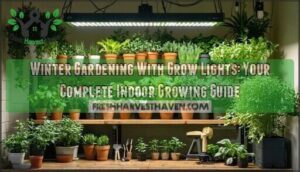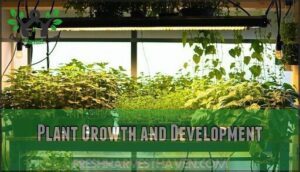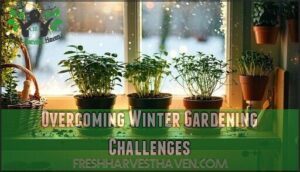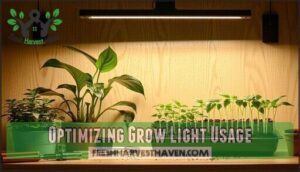This site is supported by our readers. We may earn a commission, at no cost to you, if you purchase through links.

Position lights closer for seedlings, farther for mature plants. Your spinach, basil, and microgreens won’t know it’s February outside.
The secret isn’t just having grow lights—it’s understanding how different plants respond to specific light intensities and spectrums.
Table Of Contents
- Key Takeaways
- Winter Gardening Basics
- Choosing Grow Lights
- Setting Up Grow Lights
- Plant Growth and Development
- Overcoming Winter Gardening Challenges
- Optimizing Grow Light Usage
- Frequently Asked Questions (FAQs)
- Should you use grow lights in winter?
- When should I stop using grow lights?
- How to give plants light in winter?
- Will grow lights keep plants from freezing?
- Should I use a grow light for my plants in the winter?
- What color grows light for winter?
- What lights are best for indoor plants in winter?
- Do plants need less light in winter?
- How to give plants sunlight in winter?
- How do grow lights affect plant dormancy?
- Conclusion
Key Takeaways
- Position your LED grow lights 6–12 inches above plants and run them 12–16 hours daily to replace winter’s weak sunlight and keep your indoor garden thriving.
- Choose full-spectrum LED lights over fluorescents—they’ll cut your energy costs by 75% while delivering the precise blue and red wavelengths your plants need for healthy growth.
- Start with easy wins like leafy greens, herbs, and microgreens, as they respond quickly to artificial lighting, and you’ll see results within weeks.
- Watch for light burn (bleached leaves) and stretching (leggy growth) to dial in the perfect distance and intensity—your plants will tell you what they need.
Winter Gardening Basics
Winter’s shorter days and weaker sunlight create challenging conditions for your indoor plants, but you can maintain thriving gardens year-round with proper artificial lighting.
Understanding your plants’ specific light requirements and matching them with appropriate grow light spectrums forms the foundation for successful winter gardening indoors.
Plant Lighting Requirements
During winter’s shorter days, your indoor plants face a lighting crisis that threatens their survival. Understanding light requirements transforms struggling houseplants into thriving specimens through strategic artificial illumination.
Plants need enough light to keep their metabolism running smoothly. Full spectrum grow lights give plants the complete range of light they’re used to getting from the sun.
LED grow lights are great because they can deliver exactly the right wavelengths that make plants respond the way you want.
Essential lighting requirements include:
- Intensity levels: 20-400 μmol/m²/s PPFD for low-light plants, 500-2000 μmol/m²/s for high-light species
- Daily exposure: 12-16 hours minimum during winter months for sustained growth
- Spectrum balance: Blue wavelengths for foliage development, red for flowering triggers
LED benefits include energy efficiency and targeted light delivery that boosts photosynthesis without excess heat generation. To enhance growth, it’s vital to understand plant light requirements and adjust lighting conditions accordingly.
Grow Light Design Advantages
Modern grow lights have completely changed indoor gardening. LED systems cut your electricity costs dramatically while giving you total control over light spectrums. No more dealing with uneven coverage that leaves some plants thriving while others struggle in shadows.
These LED lights slash energy use by up to 75% compared to old fluorescent setups. Smart reflective designs maximize every photon, and full spectrum options give plants exactly what they need throughout their growth cycle.
With lifespans over 50,000 hours, they keep performing consistently season after season—making winter growing both affordable and surprisingly precise.
Types of Plants Grown Under Grow Lights
Almost every plant category thrives under artificial lighting when you position them correctly. Your indoor plants transform winter into a productive growing season with proper grow lights. Leafy greens like spinach produce continuous harvests, while herb cultivation brings fresh basil and oregano to your kitchen year-round. Flowering plants such as African violets bloom magnificently indoors. Microgreen growth happens rapidly, and succulent care becomes easier with controlled lighting.
Grow lights assist diverse houseplants and vegetative plants:
- Fresh lettuce growing on your windowsill during snowstorms
- Vibrant tomato plants producing fruit in your basement
- Colorful orchids blooming multiple times throughout winter months
- Aromatic mint spreading across indoor planters year-round
- Compact jade plants maintaining their sculptural beauty indoors
Understanding the role of full spectrum lights is vital for peak plant growth and development.
Choosing Grow Lights
Picking the right grow lights can make or break your winter garden. You want to understand light spectrum because different wavelengths feed your plants in different ways.
LEDs are your best bet—they use 60% less energy than those old fluorescent bulbs.
Consider these key factors for ideal grow light selection:
- Full Spectrum LED Grow Lights deliver color temperatures between 5000-6500K for vegetative growth
- Light Intensity requirements vary by plant type—low-light plants need 10-15 watts while medium-light need 15-20 watts
- Energy Efficiency matters since you’ll run lights 12-16 hours daily throughout winter months
Color temperatures below 4000K produce warm, reddish light perfect for flowering, while higher temperatures create cool blue-white light ideal for leafy growth. The benefits of grow lights shine brightest when you match types of grow lights to your specific plants’ needs.
Setting Up Grow Lights
You’ll position your grow lights 6-12 inches above your plants and connect them to a timer for 12-16 hours of daily illumination.
This setup creates consistent photoperiods that aid photosynthesis while you adjust the light height as your plants grow to prevent leaf burn.
Positioning Lights Close to Plants
Proper light distance makes the difference between thriving indoor plants and stressed foliage. Position your grow lights 6-12 inches above seedlings and leafy greens, while mature houseplants prefer 12-18 inches for ideal height. LED lights deliver intense light intensity, so plant proximity matters—too close causes leaf burn with bleached, crispy edges.
Watch your plants like a hawk. Stretchy, leggy growth signals insufficient light, while scorched leaves mean you’re too aggressive with placement. Adjust grow light angles as plants develop, maintaining consistent coverage across all foliage. Small plants need closer positioning for adequate photon absorption, but large specimens require greater distance to prevent heat damage.
Think of it as finding the Goldilocks zone—not too close, not too far, but just right for ideal plant growth without the drama.
Setting Lights on a Timer
Once you decide to level up your indoor gardening success, automated lighting changes everything. Most houseplants do best with 12-16 hours of daily light, and automated lighting systems handle this without you having to think about it. Timer settings take the guesswork out of maintaining those consistent light cycles your plants need through winter.
Photoperiod Control isn’t just about convenience—it’s about mimicking nature’s rhythms while boosting Energy Efficiency. Your grow lights will work smarter, not harder, reducing electricity costs markedly.
Here’s what you’ll need to master:
- Choose digital timers with multiple daily programming options for precise control
- Set consistent 12-16 hour photoperiods based on your specific plant requirements
- Program gradual sunrise/sunset effects to reduce plant shock
- Monitor seasonal adjustments as winter progresses and natural light changes
- Install backup battery systems to maintain uninterrupted light intensity during power outages
Smart timer management transforms amateur winter gardening into professional-grade indoor cultivation.
Adjusting Light Height and Distance
Getting your light intensity just right makes the difference between thriving plants and struggling ones. Distance control isn’t rocket science, but it requires attention as your indoor gardening setup evolves.
Your fullspectrum LED grow lights need strategic height adjustment based on growth stages:
- Seedlings: Start 24-36 inches away to prevent burn prevention issues
- Vegetative growth: Move closer to 12-24 inches for ideal light requirements
- Flowering phase: Adjust to 12-18 inches while monitoring for stress signs
As plants grow taller, you’ll constantly tweak positioning. Watch for light burn symptoms like bleached leaves or crispy edges. Reflective surfaces can increase intensity, so factor that into your calculations. The sweet spot balances adequate coverage with burn prevention.
Plant Growth and Development
Understanding how different light spectrums affect your plants’ growth is vital for successful winter gardening.
You’ll need to balance light intensity, spectrum selection, and temperature control to enhance photosynthesis and promote healthy development in your indoor garden.
Importance of Light Spectrum and Color
Getting your plants through winter comes down to picking the right light. Think of light wavelengths like ingredients in a recipe—each one does something different for your plants.
Blue light (400-500nm) keeps plants compact and builds strong chlorophyll. Without it, your plants get tall and spindly during those dark winter months. Red light (600-700nm) triggers flowering and fruiting—it’s like flipping the switch that tells plants to reproduce.
Here’s the breakdown:
Full Spectrum
Full spectrum LED lights with the right color temperature (5000-6500K) give your plants everything they need. LEDs are efficient and let you control exactly which wavelengths your plants get, keeping photosynthesis running strong all winter.
Light Intensity and Plant Placement
When mastering indoor gardening, light intensity becomes your secret weapon for thriving plants. Position grow lights 6-12 inches from high-light vegetables while keeping shade plants at 12-18 inches distance. LED placement affects your entire grow room’s success—too close scorches leaves, too far creates weak stems.
- Light Distribution: Verify even coverage across photosynthetic zones to prevent shadowing
- Plant Spacing: Arrange specimens strategically for maximum light penetration throughout winter gardening
- Grow Room Layout: Monitor intensity levels of 150-300 µmol/m²/s for consistent plant growth
Balancing Light and Temperature
Getting good results with indoor gardening comes down to balancing your grow lights with temperature. Light spectrum matters for heat—LEDs run cooler than old-school bulbs, which makes temperature control way easier when it’s cold outside.
Photoperiod management requires monitoring both light intensity and grow room climate simultaneously. When temperatures exceed 75°F, your plants experience stress despite adequate lighting.
Energy efficiency improves when you:
- Position lights 8-12 inches from plant canopy
- Maintain 65-75°F during active growth periods
- Install circulation fans to prevent heat pockets
- Monitor leaf edges for burn signs daily
- Adjust lighting schedules based on ambient temperatures
This balance ensures ideal indoor gardening results throughout winter months.
Overcoming Winter Gardening Challenges
Winter brings unique obstacles that can stunt your indoor plants’ growth, from insufficient light exposure to temperature swings that stress your greenery.
You’ll tackle these common issues by understanding how light deprivation, overexposure, and environmental fluctuations affect plant health and implementing targeted solutions.
Light Deprivation and Solutions
When winter’s short days leave your plants looking pale and leggy, you’re witnessing classic light deprivation symptoms. Your indoor plant care in winter faces a real challenge—natural light drops by up to 80% compared to summer levels.
Light Therapy becomes essential when plants can’t meet their basic light requirements. You’ll notice yellowing leaves, stunted growth, and weak stems as photosynthesis slows down dramatically.
| Light Deprivation Signs | Grow Light Systems Solution |
|---|---|
| Yellowing, dropping leaves | Full-spectrum LED arrays |
| Leggy, stretched growth | Proper Photoperiod Control |
| Reduced flowering | Red/blue Spectrum Optimization |
| Weak root development | 12-16 hour daily cycles |
Grow Light Systems solve this winter crisis effectively. Position lights 12-24 inches above foliage and maintain consistent photoperiods. Energy Efficiency matters—modern LEDs convert 90% of electricity into usable light while cutting costs by 45%.
Your plants need 100-300 μmol/m²/s light intensity for healthy winter growth. Consistent Spectrum Optimization prevents dormancy and maintains year-round productivity indoors.
Overexposure to Light and Remedies
When your grow lights become too intense, you’ll notice leaf scorch and bleached foliage signaling photo damage. Light burn prevention starts with recognizing these warning signs early.
Adjust your light intensity by raising fixtures higher, reducing daily photoperiods, or dimming output settings. Intensity control and spectrum balancing help reverse overexposure to light damage.
Most plants recover quickly once you dial back their lighting regimen to appropriate levels.
Temperature Fluctuations and Control
Temperature swings can destroy your winter garden faster than light burns. While overexposure damages leaves, thermal regulation becomes your biggest enemy when natural heating fails. Your plants demand steady climate control—ideally 65-75°F during daylight and never below 50°F at night.
LED grow lights offer advanced heat management compared to older systems, but positioning matters. Install multiple sensors throughout your space and connect them to automated thermostat settings for consistent temperature monitoring.
Here are five proven temperature control strategies for indoor gardening:
- Position sensors at canopy level for accurate readings
- Use exhaust fans during peak heat periods
- Maintain steady air circulation to prevent hot spots
- Set thermostats with 2-3°F buffer zones
- Monitor nighttime temperatures to prevent plant growth slowdown
Optimizing Grow Light Usage
You’ve mastered the basics of winter grow lights, but maximizing their potential requires strategic adjustments for different plant types and growth stages.
Fine-tuning your light cycles, spectrum choices, and positioning transforms adequate growth into outstanding harvests of seedlings, houseplants, and edible crops.
Maximizing Seedling Development
Starting seeds indoors gives you complete control over your growing environment from day one. Position your LED grow lights 2-3 inches above emerging seedlings to prevent that frustrating leggy stretch that weakens plants. Blue spectrum wavelengths drive vigorous root development and compact growth during early stages.
Gradually increase light intensity and duration to 16 hours daily for ideal seedling nutrition uptake. Quality soil quality paired with consistent moisture creates ideal conditions that boost germination rates markedly.
Enhancing Houseplants With Grow Lights
Your houseplants can thrive indoors when you utilize the right light spectrum and grow light maintenance practices. Position LED grow lights 12-18 inches above foliage, providing 12-14 hours of daily illumination to facilitate the photosynthesis process. Group indoor plants by similar light requirements to simplify your winter gardening routine while maximizing plant nutrition absorption.
Transform your indoor gardening experience with these benefits:
- Watch drooping leaves revive within days of proper lighting
- Enjoy lush, vibrant foliage throughout winter months
- Create healthier air quality from thriving houseplants
- Maintain consistent growth despite seasonal light limitations
- Feel proud displaying your flourishing indoor garden sanctuary
Growing Herbs and Microgreens With Grow Lights
Fresh herbs and microgreens transform your winter gardening experience with LED benefits that deliver consistent harvests. Position grow light systems 6-8 inches above plants, providing 14-16 hours of full-spectrum illumination daily.
Indoor farming accelerates microgreen harvest while maximizing herb nutrition through controlled environments. This indoor gardening approach creates year-round herb gardens that thrive regardless of outdoor conditions.
Frequently Asked Questions (FAQs)
Should you use grow lights in winter?
Yes, you’ll want grow lights during winter months. Natural sunlight drops sharply, leaving your houseplants struggling. LED grow lights provide the full spectrum needed for healthy growth and photosynthesis.
When should I stop using grow lights?
Stop using grow lights when natural daylight reaches 12+ hours and you’ve gradually transitioned your plants outdoors over 7-14 days.
How to give plants light in winter?
Like winter sunlight through frosted glass, your plants need supplemental lighting. Use full-spectrum LED grow lights positioned 8-12 inches above foliage, running 12-16 hours daily on timers for consistent photoperiods.
Will grow lights keep plants from freezing?
Grow lights won’t prevent your plants from freezing since they produce minimal heat. You’ll need proper heating systems to maintain safe temperatures above freezing for your plants’ survival.
Should I use a grow light for my plants in the winter?
Before candles burned in medieval times, your plants need supplemental light when days grow shorter.
Position full-spectrum LED lights 6-12 inches above foliage, providing 12-16 hours of daily illumination to maintain photosynthesis and healthy growth during winter’s dim conditions.
What color grows light for winter?
Full-spectrum grow lights work best during winter months. They provide the complete red and blue wavelengths your plants crave, mimicking natural sunlight. Avoid single-color options—plants need the whole rainbow.
What lights are best for indoor plants in winter?
You’ll want LED full-spectrum lights positioned 8-12 inches above your plants. They provide the complete light spectrum plants need, run efficiently, and won’t overheat your greenery.
Do plants need less light in winter?
Think of plants as solar-powered machines that can’t just flip their "power save" mode on.
Plants are solar-powered machines that can’t switch to power save mode during winter
Your houseplants still need 12-14 hours of daily light in winter, even though natural sunlight becomes scarce and weak during shorter days.
How to give plants sunlight in winter?
Position LED grow lights 6-12 inches above your plants and run them 12-16 hours daily. Full-spectrum LEDs mimic natural sunlight, providing the photosynthetic energy your houseplants desperately need.
How do grow lights affect plant dormancy?
Clever grow lights cleverly disrupt dormancy by extending photoperiods beyond natural winter cycles.
You’ll need to carefully balance light duration and intensity—allowing necessary rest periods preserves healthy plant metabolism while maintaining active growth.
Conclusion
Winter gardening with grow lights turns your home into a green sanctuary when everything outside goes dormant.
You’ve figured out where to place those LEDs, which light spectrums work best for different plants, and how to fix the usual hiccups that pop up.
Your spinach won’t bolt, your basil will flourish, and your houseplants will thrive through the darkest months. Winter gardening with grow lights transforms any space into a productive oasis, proving you don’t need spring to grow fresh food.
- https://www.researchnester.com/reports/led-grow-light-market/4842
- https://garanord.md/energy-efficient-constant-lighting-options-for-winter-garden-enthusiasts-/
- https://migrolight.com/blogs/grow-light-news/energy-saving-with-led-grow-lights
- https://straders.net/blog/growing-plants-under-artificial-lights/
- https://medicgrow.com/blogs/news/what-grow-lights-are-ideal-for-overwintering-plants









